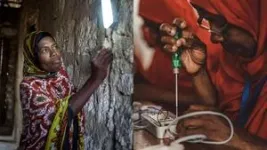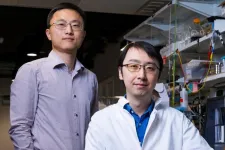(Press-News.org) Involving women in implementing solar energy technologies in developing countries not only has great climate impact. A new study published in Nature Energy and carried out by researchers from Chalmers University of Technology, Sweden, shows that empowering women through energy care work can change unjust, gendered norms and long-lived injustices.
Unlike going from fossil to renewable fuels within the transport sector, transitioning to renewable energy for electricity production is often done at the local level due to decentralised energy providers. Around the world, there are community-led programmes that provide solar, wind and hydro power, as alternative, greener energy sources. Whilst these programmes have the potential to help improve climate impact, they run the risk of maintaining deep-rooted gender imbalances through a lack of people-centred research and missing out the important, but often undervalued work of women within a community. The new study by Chalmers researchers, analyses what is needed to successfully implement a renewable energy transition programme and at the same time tackle systemic gender injustice.
“The climate crisis has put us in a position to stop and look back on our society, the rampant inequalities and the development planning being driven by over-consumption. As we chart a way out, it is important to emphasise that sustainability and justice go hand in hand. It is important to think of energy transitions as embracing social, economic and environmental aspects and here gender equality is a key”, says Kavya Michael, researcher at Chalmers University of Technology and lead author of the paper.
Technical training and female empowerment
In the recently published study “A conceptual analysis of gendered energy care work and epistemic injustice through a case study of Zanzibar’s Solar Mamas”, Kavya Michael spent time observing and interviewing women in a project led by Barefoot College International, in Zanzibar, Tanzania. The Solar Mamas-project provided women at the heart of the community with technical training to become energy providers in the transition to solar energy, giving them the skills and knowledge to install and maintain solar panels and bringing electric light to previously inaccessible spaces. This meant that businesses within the community could stay open after dark and women started occupying public spaces more in the evenings as there was light.
Through the training the women became ‘community caregivers’, and this meant that their work, both in providing solar panels and light to the community, and the work they continued to do within the household was valued and respected more.
“Women in Zanzibar were traditionally responsible for domestic energy provisioning such as collecting firewood or buying kerosene, but these were never jobs that were considered or valued. By placing a value on the roles that were previously taken for granted by the female members of the group, their role in society was advanced”, explains Michael.
The training also provided the women with a conducive environment to facilitate empowerment and change.
“What is unique about the programme at Barefoot Zanzibar is that, as well as the technical training, there was a module called ENRICHE which is part of the Solar Mamas training curriculum where they are provided with a safe space to reflect on unjust gendered norms and social practices. The women are given education about their rights, reproductive health and financial literacy, among other things. This module plays a huge role in ‘unlearning’ the systemic injustices that are prevalent in their societies”, says Michael.
Support from all levels key for success
The study shows that there is potential for locally led energy transitions to break established gender norms and successfully combine a move to renewable energy, with a gender-just society. The findings illustrate the need for energy transitions research, policy and practice to be deeply informed by lived experiences, diverse practices of care within the energy webs and valuing of multiple voices.
“I believe lessons from the Zanzibar case can give valuable insights in driving forward gender-just, locally led sustainable transitions in other settings. However, these initiatives are often not backed up by the state and hence fail to make a significant impact. In this study, we see change actually happening because the whole process of the programme, from community meetings, to recruitments, to training and follow-ups are done together with the state. Whenever there is a bottleneck, for example when male partners prevented their wives from joining the training after they were selected, the state intervenes. The truly unique part of this study, which could be recreated elsewhere, is the empowerment of women, in combination with the change of men and the whole community, working together towards energy transitions. Zanzibar is a very patriarchal space, if it can work in Zanzibar, then there is the potential for it to work in many other places as well”, concludes Michael.
A new concept focusing on energy and care
The theoretical framework used to understand this case study is unique. Using four key themes – care, knowledge, power and energy – Michael and the team from Chalmers, created a list of ‘codes’ from the interviews they conducted with the Solar Mamas, Barefoot College Staff and Government representatives. This coded framework allowed the researchers to analyse the data from the qualitative research and understand the dynamics of the project.
The findings from the study place a great value on the concept of care* and the importance in valuing this fully within a community in the transition to renewable energy. An innovative concept of gendered energy care work is described in the paper, which puts a value on the role of women in providing energy within a community to help chart a way out of the climate crisis.
“Energy and care are deeply connected in two key ways, energy can either enable or hinder care work, and care work influences energy demands. For a just energy transition that supports and fairly distributes care, it's crucial to include care in energy transition analyses,” says Kavya Michael.
This innovative approach using a lens of energy and care, helps to understand and value gendered energy care work, specifically women’s previously invisible work, as involving skilled labour in everyday life.
More about the study’s definition of care*:
In this paper Kavya Michael and Helene Ahlborg draw on the concept of care as defined by Fisher and Tronto as an activity encompassing everything we do to maintain, continue, and repair our world to live in it as well as possible. This world includes our bodies, ourselves, and our environment, all of which we aim to weave into a complex, life-sustaining web. Building on this definition, the researchers introduce the concept of ‘energy care work’, referring to the daily practices at household and community levels that involve provisioning, sustaining, maintaining, repairing, and ensuring the availability of energy carriers and services for everyday life. This perspective on energy care work not only focuses on caring for people but also on the infrastructures and technologies, and their environmental impacts. It is based on the lived experiences of dependence and relationships within energy networks, recognising the intricate connections between individuals, energy systems, and the ecosystems that support their daily activities.
More about Barefoot College International:
Initiated in 1997 by Barefoot College in Rajasthan, India, the Solar Mamas programme now spans more than 90 countries worldwide.
The project’s mission is to make vocational and educational opportunities accessible to women and girls from the most marginalised communities around the world. The organisation believes that providing these opportunities to women is the solution to ensuring long term climate, economic and social resilience for rural communities globally.
More about the research:
The article “A conceptual analysis of gendered energy care work and epistemic injustice through a case study of Zanzibar’s Solar Mamas” is published in Nature Energy.
The article is written by Kavya Michael and Helene Ahlborg, and they are both active at Chalmers University of Technology in Sweden.
This study has been funded by the Swedish Energy Agency and is conducted under a larger project ‘Empowering all: gender in policy and implementation for achieving transitions to sustainable energy’ under the User-Centred Energy Systems (UsersTCP), part of the IEA Technology Collaboration Programme, task on Gender and Energy.
For more information, please contact:
Kavya Michael, Researcher, Environmental Systems Analysis, Department of Technology Management and Economics, Chalmers University of Technology, Sweden kavyami@chalmers.se +46 31 772 20 22
The researcher speaks English and may be available for live and pre-recorded interviews. At Chalmers, we have podcasting studios and film equipment on site and can assist requests for TV, radio, or podcast interviews.
END
Empowering women – a key to both sustainable energy and gender justice
2024-08-13
ELSE PRESS RELEASES FROM THIS DATE:
Delivery robots’ green credentials make them more attractive to consumers
2024-08-13
PULLMAN, Wash. – The smaller carbon footprint, or wheel print, of automatic delivery robots can encourage consumers to use them when ordering food, according to a Washington State University study.
The suitcase-sized, self-driving electric vehicles are much greener than many traditional food delivery methods because they have low, or even zero, carbon emissions. In this study, participants who had more environmental awareness and knowledge about carbon emissions were more likely to choose the robots as ...
Mayo Clinic offers new innovative therapy to treat atrial fibrillation
2024-08-13
ROCHESTER, Minn. — Cardiologists in Mayo Clinic's Heart Rhythm Clinic are using a new innovative energy source to safely and successfully treat a common type of heart arrhythmia. The therapy, called pulsed field ablation (PFA), has received Food and Drug Administration (FDA) approval and represents a significant milestone in treating atrial fibrillation (AFib).
The irregular and often very rapid heart rhythm of AFib can lead to blood clots in the heart, increasing a patient's risk of stroke. Clinicians can use medication and therapies to help reset the heart rhythm, but some patients have AFib that ...
Changing food consumers' choices may help cut greenhouse gases
2024-08-13
Planet-warming greenhouse gas emissions associated with the global food supply chains induced by diets could fall by 17% if people change their food choices towards more plant-based diets, a new study reveals.
Researchers believe that a currently over-consuming 56.9% of the global population would save 32.4% of global dietary emissions by changing their diet to the planetary health diet proposed by the EAT-Lancet Commission.
Publishing their findings today (13 Aug) in Nature Climate Change, an international group of researchers note that a diet switch to the planetary health diet would balance the ...
Significant link found between heme iron, found in red meat and other animal products, and type 2 diabetes risk
2024-08-13
Key points:
Researchers identified a significant link between heme iron—iron found in red meat and other animal products —and risk of type 2 diabetes (T2D), as well as the metabolic pathways underlying the link.
Non-heme iron—iron found in plant-based foods—was not associated with risk of T2D.
The study suggests that cutting down on heme iron from red meat and adopting a plant-rich diet can help lower diabetes risk. And it raises concerns about the addition of heme to increasingly popular plant-based meat alternatives.
Boston, MA—Higher intake ...
Older adults’ life satisfaction varies by immigrant status, living arrangement and social disposition
2024-08-13
TORONTO, ON – Do older adults who live alone feel less satisfied with their lives? A new analysis of about 12,000 respondents aged 65 and older reveals that what matters for Canadian older adults’ life satisfaction is not living alone per se. Rather personality-based social dispositions play a key role in how older adults feel about living alone. In addition, the role these dispositions play tend to differ between Canadian-born and immigrant older adults.
The researchers found that despite the existence ...
Say ‘aah’ and get a diagnosis on the spot: is this the future of health?
2024-08-13
A computer algorithm has achieved a 98% accuracy in predicting different diseases by analysing the colour of the human tongue.
The proposed imaging system developed by Iraqi and Australian researchers can diagnose diabetes, stroke, anaemia, asthma, liver and gallbladder conditions, COVID-19, and a range of vascular and gastrointestinal issues.
Engineering researchers from Middle Technical University (MTU) and the University of South Australia (UniSA) achieved the breakthrough in a series of experiments where they used 5260 images to train machine learning algorithms to detect tongue colour.
Two ...
Rapid removal of emerging endocrine disruptors in wastewater using high-performance single-atom catalysts
2024-08-13
Bisphenols are widely used as the main raw material for plastics such as receipts, water bottles, water containers, and vinyl due to their heat-resistant and mechanochemical properties. Among bisphenols, bisphenol A (BPA) that we often refer to as an "endocrine-disrupting chemicals" has been linked to adverse effects on reproduction, development, intelligence, and various metabolic diseases. Bisphenol F (BPF), a recently developed alternative to BPA Bisphenol A has also been reported in the literature to cause neurological disruption and various health risks.
Dr. Jong Min Kim of the Materials Architecturing ...
Starvation and adhesion drive formation of keratinocyte patterns in skin
2024-08-13
Cell–cell adhesion-induced patterning in keratinocytes can be explained by just starvation and strong adhesion, Hokkaido University researchers find.
Fingerprints are one of the best-recognised examples of pattern formation by epithelial cells. The primary cells in the epithelium are the keratinocytes, and they are known to form patterns at the microscopic and macroscopic levels. While factors affecting this pattern formation have been reported, the exact mechanisms underlying the process are still not fully understood.
A team of researchers, led by Associate ...
Ships now spew less sulfur, but warming has sped up
2024-08-13
RICHLAND, Wash.—Last year marked Earth’s warmest year on record. A new study finds that some of 2023’s record warmth, nearly 20 percent, likely came as a result of reduced sulfur emissions from the shipping industry. Much of this warming concentrated over the northern hemisphere.
The work, led by scientists at the Department of Energy’s Pacific Northwest National Laboratory, published today in the journal Geophysical Research Letters.
Regulations put into effect in 2020 by the International Maritime Organization required a roughly 80 percent reduction in the sulfur content of shipping ...
Rice-built reactor yields green ammonia and purified water
2024-08-13
HOUSTON – (Aug. 12, 2024) – Ammonia plays a critical role in sustaining food production for the world’s growing population, but making it accounts for about 2% of global energy consumption and 1.4% of carbon dioxide emissions. Rice University engineers have developed a revolutionary reactor design that could decarbonize ammonia production while also mitigating water pollution.
In a study published in Nature Catalysis, a team of Rice engineers led by Haotian Wang described the development of a new reactor system that converts nitrates — common pollutants found in industrial wastewater and ...





